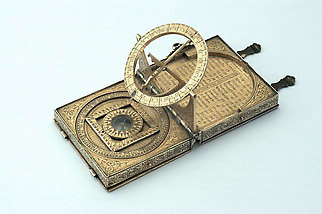
 |
| Catalogue |
 |
 Astronomical Compendium This canting (i.e. allusive) badge is a circular device showing a three-trunked tree with a bird perched on an upper branch and a folded scroll representing its song: 'IVGGE IVGGE IVGGE IVGGE'. The bird is a nightingale, whose song was conventionally described as sounding like 'jug jug'. Although the fine details differ, Cole engraved the same badge on his map of the Holy Land for Jugge's 1572 edition of the Bishops' Bible. Simpler versions of Jugge's device also appeared in some of his other publications. It may not be coincidence that in 1568, the same year as this compendium, Jugge became Master of the Stationers' Company, which regulated the printing trade. Surrounding the circular badge on the front cover is strapwork engraving, decorated with squirrels, snails, foliage and fruit. The edges and otherwise free areas of the internal plates also carry foliate decoration. The back cover and clasps are presumably replacements. The inside of the back cover is uncharacteristically blank and the decorative border and central foliate design of the outer face differ in style from the rest of the instrument. The two projections on the front cover show however that clasps would originally have been present. A suspension ring enables the compendium to be worn as a pendant. On the inner side of the front cover is a quadrant with folding sights. It is titled 'A quadrant . to. take . <the> . hight . of . <the> . so<n>ne . [Moon] . [star] . and . <the> hight . of . toures . or . any . other . buildi<n>ges'. There are two arc scales. The outer is a 'Quadrans Astronomicus', divided to 10 and 1 degrees and numbered both ways by 10. The inner scale provides a 'Quadrans Geometricus' from 0 to 12 to 0, divided by 3, 1 and 1/2 and numbered by 3. At respective ends of the scale are the shadow square titles: 'Vmbrae Rectae' and Vmbrae Versae'. To use the quadrant, a plumb bob would have been fitted to the projecting pin at the vertex. Facing the quadrant on one of the two main leaves are two compartments, each held in place by two clips in the shape of a pointing hand. The decorated lids of the compartments are engraved with the names of the items they once held (now missing): 'THE . COMPASE . SQVARE . & . RVLE .' and '.THE . WRYT.TINGE . PENNE .' The other face of the first leaf carries a compass with geometrical square and circle of degrees. The compass has a blued needle in a silvered bowl and is circled by a compass rose indicating 32 points with a fleur-de-lis for north. Tangent to the compass rose is a geometrical square, each side of which runs 12 to 0 to 12, divided to 3 and 1, and numbered by 3. Surrounding the square is a circular scale of degrees from 0 to 360, divided to 10 and 2, and numbered by 10. All these elements are constructed as a single, removable unit and the assembly of compass, square and circle is located by a pin and retained by a spring on the other face of the leaf. Hinged between the two main leaves is a universal equinoctial dial. The upper face of the hour ring is graduated for a full 24 hours, each hour in Roman numerals and divided to 1/2 and 1/4. A semicircle of the underside is similarly divided and numbered from VI to VI. A quadrant moving in a slot enables the dial to be set for latitude. Both sides of the quadrant are divided to 10, 2 and 1, and numbered by 10. The plummet which would have acted as an index for the quadrant scale is now missing; it hung from a hole at the vertex of the quadrant's frame. The dial folds flat into a recess on the second leaf, whose face carries a table of 'THE . LATITV{DES} OF . PRINCIPALL . TOWNES'. Between the two columns of 33 towns (almost half of which are in England), there is the inscription 'HVMFRAY . COOLE . MADE . THIS . BOKE + ANNO . 1568 .' The reverse of the second leaf contains a calendar for January to June. Each day is given its golden letter and the calendar is marked for the days when the sun enters a sign of the zodiac and for the start of the seasons. A selection of saint's days is also included. The format of the calendar matches the layout used by Leonard Digges in his Prognostication Everlasting, first published in the 1550s and reprinted throughout the second half of the century. The other half of the calendar is now missing. It would have appeared either on the inside of the original back cover or on an additional leaf attached to it and fitting into the recess in the calendar leaf. See R. T. Gunther, "The Great Astrolabe and other Scientific Instruments of Humphrey Cole", Archaeologia, 76 (1927), pp. 273-317, esp. pp. 281-5. Stephen Johnston |



